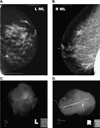Radioactive seed localization compared to wire localization in breast-conserving surgery: initial 6-month experience
- PMID: 23943024
- PMCID: PMC4003499
- DOI: 10.1245/s10434-013-3166-4
Radioactive seed localization compared to wire localization in breast-conserving surgery: initial 6-month experience
Abstract
Background: Wire localization (WL) of nonpalpable breast cancers on the day of surgery is uncomfortable for patients and impacts operating room efficiency. Radioactive seed localization (RSL) before the day of surgery avoids these disadvantages. In this study we compare outcomes of our initial 6-month experience with RSL to those with WL in the preceding 6 months.
Methods: Lumpectomies for invasive or intraductal cancers localized with a single (125)iodine seed (January-June 2012) were compared with those using 1 wire (July-December 2011). Surgeons and radiologists did not change. Positive and close margins were defined as tumor on ink and tumor ≤1 mm from ink, respectively. Demographic and clinical characteristics and outcomes were compared between RSL and WL patients.
Results: There were 431 RSL and 256 WL lumpectomies performed. Clinicopathologic characteristics did not differ between groups. Most seeds (90 %) were placed before the day of surgery. Positive margins were present in 7.7 % of RSL versus 5.5 % of WL patients, and 16.9 % of RSL versus 19.9 % of WL had close margins (p = 0.38). The median operative time was longer for lumpectomy and sentinel lymph node biopsy (SLNB) in the RSL group (55 vs. 48 min, p < 0.0001). There was no significant difference in the volume of tissue excised between groups.
Conclusions: In the first 6 months of RSL, operative scheduling was simplified, while rates of positive and close margins were similar to those seen after many years of experience with WL. Operative time was slightly longer for RSL lumpectomy and SLNB; we anticipate this will decrease with experience.
Conflict of interest statement
Figures

References
-
- Lovrics PJ, Goldsmith CH, Hodgson N, et al. A multicentered, randomized, controlled trial comparing radioguided seed localization to standard wire localization for nonpalpable, invasive and in situ breast carcinomas. Ann Surg Oncol. 2011;18:3407–3414. - PubMed
-
- Rampaul RS, Bagnall M, Burrell H, et al. Randomized clinical trial comparing radioisotope occult lesion localization and wire-guided excision for biopsy of occult breast lesions. Br J Surg. 2004;91:1575–1577. - PubMed
-
- Arentz C, Baxter K, Boneti C, et al. Ten-year experience with hematoma-directed ultrasound-guided (HUG) breast lumpectomy. Ann Surg Oncol. 2010;17(Suppl 3):378–383. - PubMed
-
- Klein RL, Mook JA, Euhus DM, et al. Evaluation of a hydrogel based breast biopsy marker (HydroMARK(R)) as an alternative to wire and radioactive seed localization for non-palpable breast lesions. J Surg Oncol. 2012;105:591–594. - PubMed
-
- Monti S, Galimberti V, Trifiro G, et al. Occult breast lesion localization plus sentinel node biopsy (SNOLL): experience with 959 patients at the European Institute of Oncology. Ann Surg Oncol. 2007;14:2928–2931. - PubMed
Publication types
MeSH terms
Substances
Grants and funding
LinkOut - more resources
Full Text Sources
Other Literature Sources
Medical

